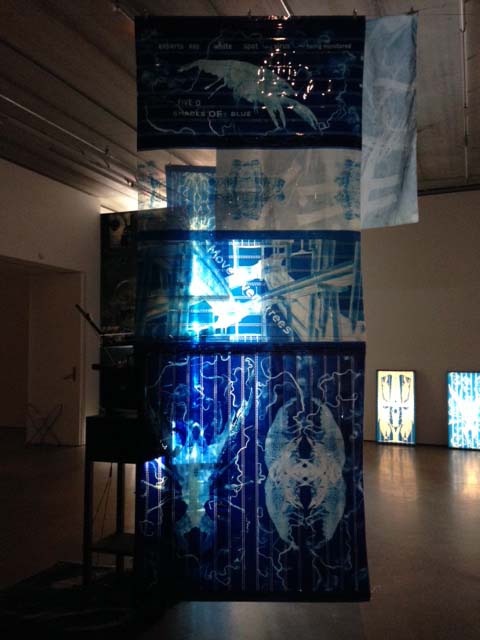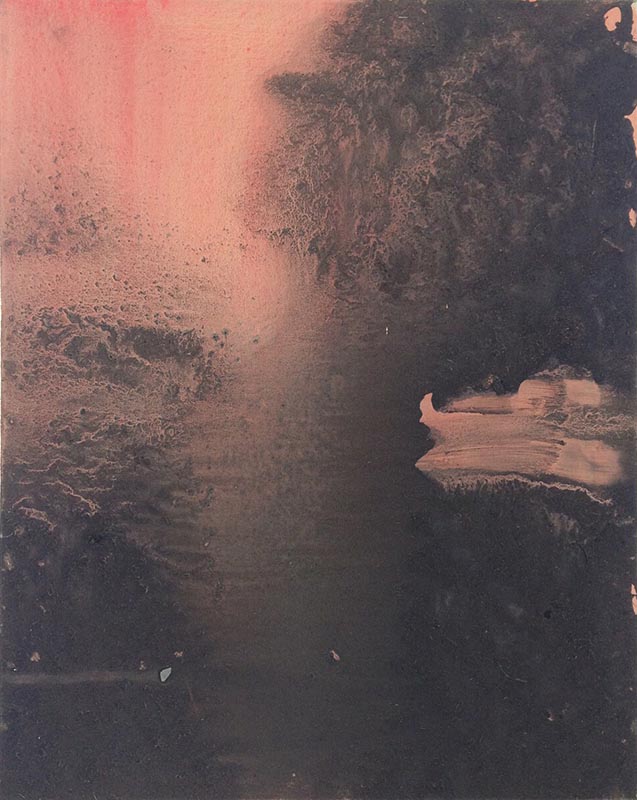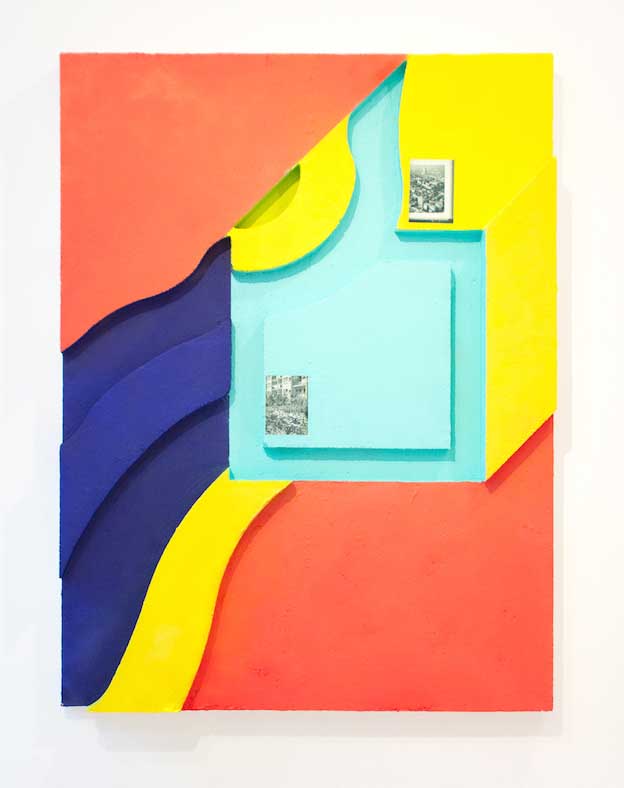 |
| Klas Eriksson, Curva Viola, 2012, image: Sebastian Nitulescu |
Stockholm, Dec. 2012: Stockholm-based Swedish artist Klas Eriksson (b. 1976) has been incredibly active in Scandinavia, with exhibitions and performances ranging from participating in the Royal Institute of Art’s “Performing Recalcitrance” to the Copenhagen Arts Festival to a solo exhibition at Nordin Gallery in Stockholm. He has also participated in several large-scale international exhibitions such as the Bucharest Biennale and the Göteborg International Biennial for Contemporary Art. My decision to interview him stems not from his extensive exhibition history and accolades, but from my odd fascination with his public space works and interventions, which are truly beautiful and somewhat shocking at times.
For instance, in his recent work Mono Colored Atmosphere (2012), he interrupted Copenhagen’s city life by changing the color of the immediate atmosphere to a bright orangish-red, igniting several smoke bombs simultaneously with the help of the surrounding community and viewers—unexpected for an everyday pedestrian to encounter. Even somewhat apocalyptic. The colored panorama could be confused with some unwanted emergency scenario where one needs to evacuate because of an actual or perceived threat, but many find something fantastic about the experience of being immersed in this unexpected energy. Some of Eriksson’s other works set entire architectural structures ablaze—not really on fire, but they appear to be—such as tall skyscrapers or long bridges at night which are astonishing to witness.
Jacquelyn Davis: I’m intrigued by how you have been able to follow through with some of your public performances which border on being illegal or public disturbances. I’m thinking of Mono Colored Atmosphere (2012), Com’ on you Reds (2012) and Who are ya!? (2011). What is the process of getting permission to complete such works?
Klas Eriksson: The process usually starts with a phone call to the police, with an explanation that art is important. For bigger appearances—biennales and festivals—it’s common that those who invite me handle this issue. For Mono Colored Atmosphere, Christian Skovbjerg Jensen did a fantastic job, having many long meetings with the local police who agreed in the end. These kinds of performances involving visual manners from football stadiums, despite permission or otherwise, always attract the police. They have become a serious part of these performances; they show up and add something unpredictable. After performing Who are ya?!, there was a terrorist threat towards the art hall Röda Sten underneath the bridge. The day after, the local newspaper claimed that the performance may have fooled the national security (Säpo) to act, since the visuals of the piece were read as “terror” related by the journalist. In short, a “yes” is needed from the police.
JD: Do you consider yourself a street artist? Have you ever claimed to be an outsider artist? You aren’t exactly “under the radar,” but your strategies for interacting with the community and public spaces seem to speak to the tradition of street and “hooligan” art.
KE: I have never seen myself as a street artist; I’m not a big fan. My works are not permanent. You can’t find traces that they took place after they are done—except in documentation. I don’t see myself as an outsider artist either. I’m just doing my thing, and I think it’s inside the real world. The art world often perceives it as “hooligan” art, but it’s more so a swap of context to raise new questions and readings on and in the public space and those who occupy it. Visual experience is multi-layered; it can be seen as hostile and beautiful simultaneously. Participants involved in these performances have experiences which are purely fun.
JD: How does your personal history relate to your practice? Do you believe that your art reflects any particular demographic—or yours? If so, what is this demographic?
KE: Since I was little, I’ve always hated when others tried to tell me how to do things. Most of my friends are the same way—independence is really attractive. Maybe this is why my work could be read as hooligan or outsider art; for me, it’s about following your guts and doing what you have to do in order to cope with existence. When people tell you what and how to be, it works to an extent, but most of the time, I think it only creates angst and limits your own persona into something that “works” for others.
JD: Your artist statement tells me that you are interested in “control, power and limitations.” What exactly interests you about these subjects? Why are you pursuing these concepts within your practice?
KE: I constantly struggle with these three subjects—having them in my statement is a way of trying to be truly honest. They always become visible towards the end of my working process and can be seen as kind of an essential resistance in order to be able to work. I see resistance as a quality. It’s easy to feel controlled by “others” in one way or another, and in my art practice, I deal with this. Often, the outcome of public performances is not controlled; it would be boring if I knew exactly what would happen during a performance. Power has to do with visible and less visible power relations that I find appealing, and at times, I have to challenge them. Limitations work as a trigger for myself as well as for the viewers—what happens when you have to do the wrong thing in order to get what you want, despite limitations? Stepping over borders is always interesting.
JD: Lately, you have created public space performances in a number of cities across Scandinavia and Europe. Is this your modus operandi now? You also work with video and sculpture, so how do you go about classifying works among these different modes? Is it difficult to classify one work as either a performance or sculpture or—?
KE: I like your use of the phrase modus operandi, which is mostly used in police work to describe a criminal’s approach [laughs]. In 2007, I started to do unannounced collective performances in public spaces. Somehow, I wanted to cut to the core, see and experience something different. It became a lot about temporary actions in a performative way. These experiences led me to explore notions on architecture, mediated images, subcultures and addressing a public subconscious. There have been many of these types of performances lately; at the moment, my focus is on changing public space and its architecture. I ran into difficulties when classifying this work. The architecture that I choose to work with can be seen as a temporary sculpture yet also as collective performance. It’s a delicate problem I confront—it feels as if it’s turning more into sculptures since architecture is currently in focus. My video works are really made as videos [documentation]. But during the documentation of a performance, I use a static angle—simply capturing what is happening—and I always use a title which indicates that it’s documentation and not an attempt to do video work.
JD: What is your relationship with text? Your artist statement is simple yet concise; this is a tendency or position I have seen many artists adopt lately—that less is more. Does text support your works, add or take away from them?
KE: Text supports my art to an extent, but it’s not something that I think about too much. All text produced in relation to my work can be seen as an important aspect of definition and interpretation—which is fine—but my take on art is to trigger the individual brain and not to give away too much in a piece of paper associated with the shown art work. My work is highly visual, less textual at the moment.
JD: You are excellent at documenting your work, often relying upon video. The presence and power of media is something you investigate. Do you have a goal in mind when it comes to media as a definite force?
KE: I publish almost all of my videos on youtube, since performances are made in the public space and the semiotics or entrance into the work often has a popular culture connotation. The performances are made in a context where they also should be easy to find or look upon. But this is mainly in regards to public collective performances. Media is a force used to show work, but I’m not searching for it or trying too hard. It’s just a way of showing work which I find easy and honest.
JD: Your work often appropriates logos and recognizable visual elements from pop culture which have been used and abused, depending on the circumstance. Give examples of how you manipulate these prevailing symbols to your benefit.
KE: It’s maybe more on a theoretical level where the power of art becomes visible. If I have the logotype of the academy tattooed and paid for by the academy, the academy can be seen as following a corporative logic, but it also works as a personal tattoo. The name or logo sticks to you even without a tattoo; you always state your education in your CV. I try to manipulate them in a kind of 51/50 relationship, where the logotype and its meaning are challenged in an artistic expression, becoming something more. I’m interested in creating new takes on given symbols—some of which are taken for granted in a certain context.
When Kalmar Konstmuseum didn’t register www.kk.se in time, the site was taken by a porno company (kk.se, Knullkontakt … how do you translate this so it works?) that I accidentally entered while looking for Kalmar Konstmuseum’s site. For me, it became a metaphoric experience, between the relationship of the artist and institution. We fuck each other from time to time, but we don’t want a serious relationship. So I made these fabric hipster bags with the Kalmar Konstmuseum logo and added ”dot se.” I printed 200 kk.se bags and gave them out for free during the opening. The bag has the cultural institution’s logo but with the porno company’s website.
JD: The word “intervention” is loosely used, with almost as much frequency as certain mediums: painting, sculpting, video, photography, et cetera. You intervene on many levels, but what and how do you specifically intervene—with what purpose in mind?
KE: During collective performances, I intervene a kind of staged, collective action in the public space. Seeing a group of people doing something in sync without a specific outspoken idea, or text for that matter, makes people react and hopefully begin thinking about what they are experiencing. My interventions address a slumbering, public subconscious. The interpretation of the piece lies open to anyone who wants to claim it—perhaps, creating a public discussion on what it means.
JD: Has anyone intervened in your creative plans? Has an unpredictable force or individual interrupted any of your projects? If so, what happened?
KE: The police is a present “character” in my public performances; their outcome is always unpredictable. They appear, with their blue lights complementing the given visual experience, maybe turning an experience into a hostile reading to an extent. For most performances in the public space, people intervene, but that’s part of the idea. It’s not really my public space; I don’t want to fully control the outcome. In Bucharest, a landlord wanted to kill me for having purple smoke in his public space. When he was done with his accusation, people thought the performance was over and started to applaud his appearance, making him even more pissed off. In the work Youths (2011), a group of young people near Stockholm’s central station were handed a thirty-meter roll of paper along with black and red spray cans; they were told to do whatever they wanted with it all. They created a thirty-meter long painting. During this performance, there were several social workers present who thought I was irresponsible and stupid for giving black and red spray cans to youths, which says a lot about their approach towards youths.
JD: Are you content with the Scandinavian art scene as it stands? What would you like to see change or happen?
KE: By nature, I’m never fully content. The right wing government and their rather strange way of looking at culture as a whole is a turn-off, but if I was to focus too much on that, I would only endlessly complain. I do my thing, and sometimes it could be directed towards a more political atmosphere, even though I define it as more poetic. I would like to see the Swedish Democrats vanish totally, and museums should be free of charge.
JD: Whose art is disturbing or bothering you now? Why?
KE: [Laughs] Yesterday, I thought that triangles in art are over the top. I don’t like art that has a thoughtful meaning, that reveals something or makes you go “aha.” Art should be a challenge—not a teaching method for others to get your point. It’s nice to not know what you’re looking at, but it still gets to you.
JD: What’s on your playlist? What are you reading, watching? What sights, sounds and literature are you absorbing? More importantly, which ones are influencing you?
KE: Top 4 on my playlist: Die Antwoord “Rich Bitch,” Kano “P´s and Q´s,” Diplo “Barely Standing” and Black “Wonderful Life.” I’m absorbing dialogues—everything from happy hour prices, to having a cat or not, the art market, to Stockholm being a drag compared to Berlin. Right now, I’m planning what to read for my residency at Platform in Finland this winter. I will re-read Chantal Mouffe on antagonism. I’m also watching In Treatment with my girlfriend.
To see the interview in context, click here.








